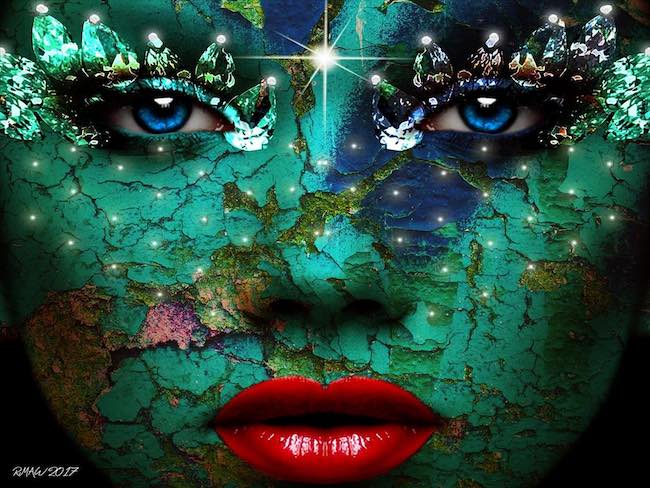L’arte contemporanea si struttura spesso attraverso contaminazioni impensabili fino al secolo scorso, divenendo testimonianza di quanta apertura vi sia stata rispetto alle linee guida tradizionali che avevano dominato il passato artistico; di conseguenza lo stesso approccio esecutivo dei creativi si modifica e si adatta alla loro personale inclinazione, senza che vi siano limiti né sulla scelta dei soggetti della narrazione emozionale, né sullo stile espressivo e neanche sulla tecnica attraverso cui lasciar trapelare le proprie sensazioni o liberare la propria fantasia. L’artista di cui vi racconterò oggi affronta e manifesta il suo ricco e sensibile mondo interiore reinterpretando e mescolando una modalità narrativa fotografica all’innovazione della modificazione dell’immagine di tipo digitale, concentrandosi sui volti di personaggi immaginari ispirati a volte alle tecnologie del mondo del cinema.
Il momento storico tra la fine dell’Ottocento e gli inizi del Novecento, non solo vide l’arte tradizionale rivoluzionarsi a causa di un vento innovativo a cui i salotti culturali più conservatori non riuscirono a opporsi, bensì fu testimone dell’avvento di nuovi metodi di riproduzione dell’immagine inizialmente ostacolati a causa della loro freddezza, della mancanza della mano del pittore a infondere talento e maestria a un ritratto o a un paesaggio. La , questo il nome dell’innovativa scoperta, pur essendo ancora limitata al bianco e nero sostituì di fatto il lavoro dell’artista soprattutto per quanto riguardava i ritratti di famiglia poiché garantiva un’alternativa molto più economica, e dunque più accessibile, con un risultato più fedele alla realtà; l’avvento di questa tecnica incontrò opposizione anche negli artisti stessi, molti dei quali decisero di creare movimenti in cui il gesto plastico fosse predominante sull’osservato, affermando in tal modo la superiorità dell’arte. Il Suprematismo, il De Stijl, l’Astrattismo Lirico e Geometrico, tutti tendevano, almeno nell’intenzione iniziale, a distaccarsi dalla rappresentazione di un’immagine che poteva facilmente essere riprodotta da un apparecchio freddo e impersonale. Superata la prima fase di sperimentazione e di dissenso, la fotografia assunse connotazioni diverse da quelle della ritrattistica e cominciò a diventare un mezzo in cui lo sguardo dell’esecutore dello scatto faceva la differenza sul risultato finale; grandi nomi come Doisneau, Henri Cartier-Bresson, Sebastiao Salgado, Gianni Berengo Gardin, hanno immortalato e lasciato ai posteri attimi di poesia senza tempo e densi di emozioni. Ma l’evoluzione e la rapidità con cui si susseguivano le innovazioni nel Novecento condussero ben presto alla scoperta di nuovi mezzi di realizzazione e di generazione di immagini, come il computer che vide la nascita della Computer Art, nata da un’idea di Ben Laposky e Manfred Frank, poi trasformatasi in Digital Art la quale non solo poteva creare segni grafici dal nulla ma anche andare ad agire e a modificare attraverso un raffinato processo di editing, le fotografie scattate con i nuovi apparecchi digitali. Dall’abbellimento di un’immagine preesistente, alla creazione e sovrapposizione di scatti a modificazioni completamente digitali, il raggio di azione della Digital Art è sterminato e si presta alla personalizzazione di ciascun creativo. Robin Wagenvoort, artista olandese nato in una famiglia di musicisti, scopre presto che la sua inclinazione naturale lo spingeva verso un’altra forma espressiva, quella figurativa legata principalmente alla fotografia. Assecondando la sua indole i genitori gli permisero di seguire gli studi specifici, seguendo corsi di ritratto, fotografia in studio, fotografia architettonica, fotografia meccanica, editing di immagini e progettazione grafica con il programma Indesign che poi però sceglie di approfondire da autodidatta.
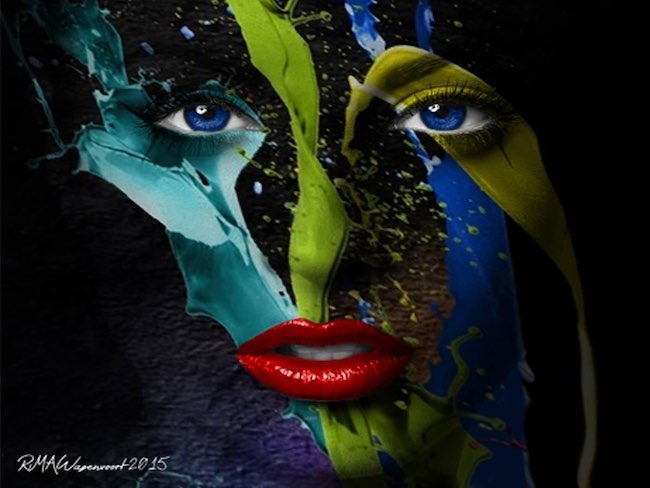
Affinando successivamente la tecnica dell’editing con l’artista Jaap Baart, che intravedendo il talento di Robin Wagenvoort accetta di dargli lezioni private, ha la possibilità di applicare le tecniche più avanzate alla sua maestria nel ritratto a cui unisce la fantasia e la visionarietà che lo inducono a dar vita immagini affascinanti e misteriose a volte ispirate a un altro mondo creativo, quello del cinema, in cui la tecnica e gli effetti speciali affiancano le abilità degli attori ma anche di tutto quel substrato invisibile costituito da truccatori, scenografi, direttori della fotografia il cui lavoro è essenziale per il risultato finale e la buona riuscita di ogni pellicola.
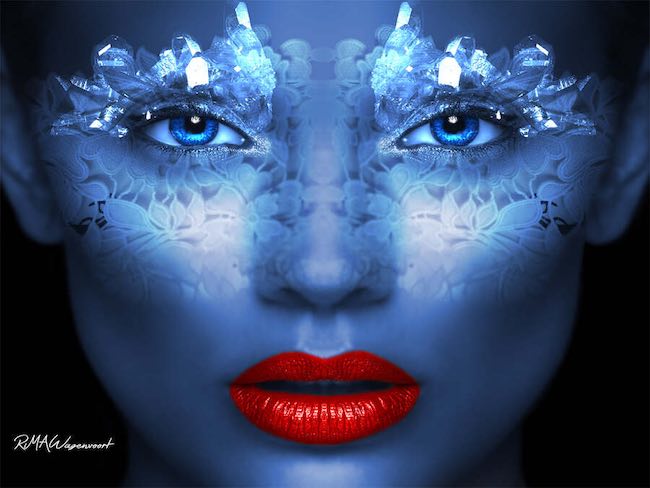
La fantasia di Wagenvoort lo conduce a mescolare i volti di bellissime modelle, di cui riesce a far fuoriuscire un fascino misterioso e magnetico nei confronti dell’osservatore che non riesce a sfuggire all’intensità dello sguardo su cui si concentra l’essenza espressiva dell’artista; ma il tratto più distintivo è la sua capacità di plasmare letteralmente le immagini di base intervenendo con un editing tridimensionale che consente ai volti di assumere una sembianza fantascientifica, sorprendente e ipnotica. Le sue modificazioni digitali aprono lo sguardo al sogno di un mondo che va oltre il soggetto ma che di fatto appartiene al suo ricordo, ai suoi desideri, a un vissuto di un frangente particolare oppure a qualcosa di ancora non sperimentato ma che vorrebbe vivere, o ancora ad alcune caratteristiche dell’essere umano che si svelano in virtù delle metafore con cui Wagenvoort di volta in volta accompagna i suoi protagonisti; l’opera Peacock Face (Faccia di pavone)
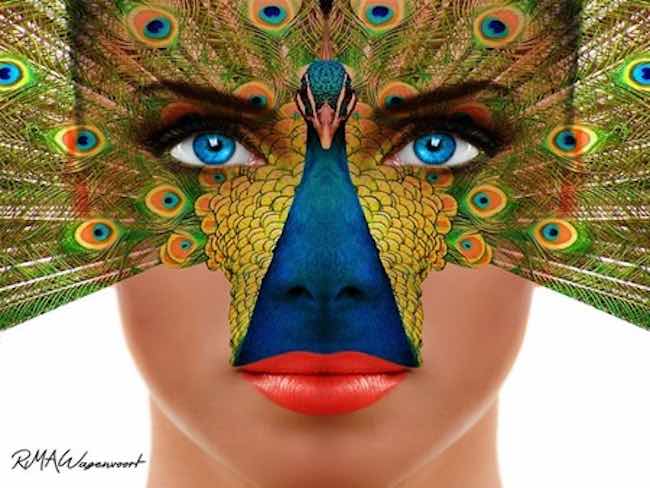
racconta la vanità, uno dei peccati capitali secondo la religione cattolica ma in fondo anche parte imprescindibile della natura umana, in particolar modo nella contemporaneità dove l’apparire supera persino l’essere. Non vi è giudizio da parte dell’artista, piuttosto accettazione di un modo di essere anche laddove sia distante dal proprio, ammirazione nei confronti di una sicurezza in se stesse che le persone che tendono a prendersi cura della propria immagine mostrano, malgrado a volte celino fragilità interiori mai svelate. Nelle due opere dedicate a Venezia invece Wagenvoort affronta tematiche diverse perché in fondo l’essere umano non è che una composizione di emozioni e di umori sulla base del momento vissuto, oppure interpretabile sulla base delle differenze caratteriali ed esistenziali; in Bellezza di Venezia Face
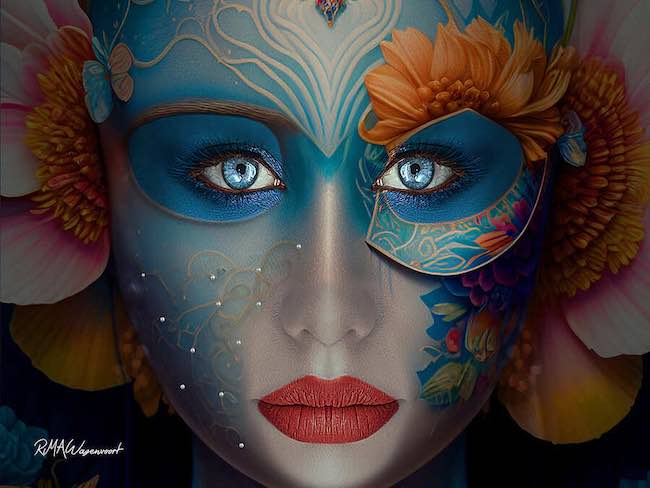
infatti il tema è quello delle maschere, sia quelle belle e scenografiche del celeberrimo carnevale della città lagunare, sia quelle che l’uomo indossa per nascondere la propria essenza o per adeguarsi all’ambiente che lo circonda, come un camaleonte che troppo spesso in quel suo modificarsi mette in secondo piano se stesso fino al punto di dimenticare chi sia davvero. In quest’opera emerge la difficoltà contemporanea, ma che in fondo è appartenuta a ogni epoca, di dover corrispondere a un modello in contrasto con le caratteristiche naturali dell’individuo e che genera una frustrazione dovuta al timore di non riuscire mai a essere se stesso fino in fondo. In Venice Face
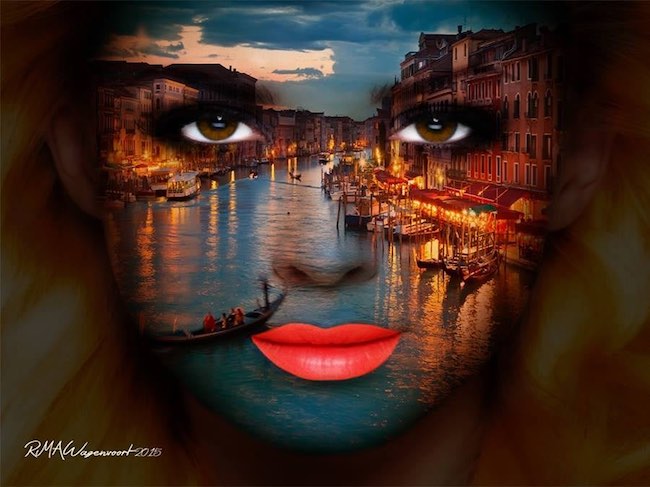
invece Robin Wagenwoort concentra l’opera sul sentimento del ricordo, su quella memoria emotiva che si lega indissolubilmente a un luogo vissuto, a immagini rimaste all’interno di quello scrigno interiore che si può aprire ogni qualvolta l’interiorità sente il bisogno di riconnettersi con una sensazione respirata, percepita in un frangente particolare. Qui la sovrapposizione sul volto è costituita dalle immagini acquatiche e caratteristiche di Venezia, come se la protagonista non volesse distaccarsi dall’incantevole momento in cui i suoi occhi si sono persi nella bellezza. E ancora in The vision of Nelson Mandela (La visione di Nelson Mandela),
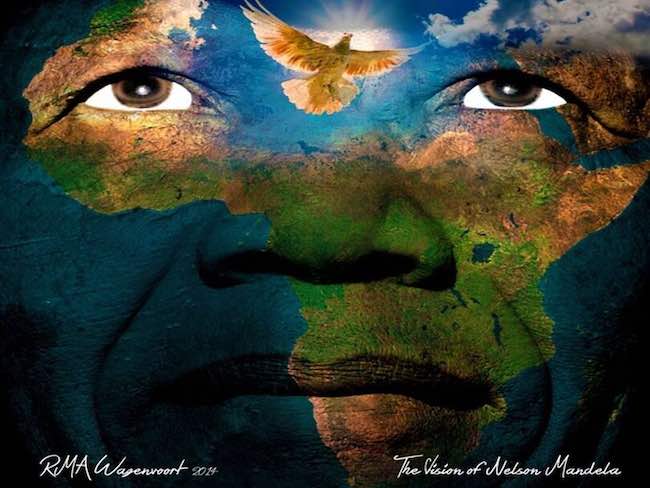
Wagenvoort rende omaggio al grande politico sudafricano e al suo sogno di sconfiggere la segregazione razziale trasformando il suo paese, ma anche tutta l’Africa e perché no? il mondo intero, in un luogo dove bianchi e persone di colore potessero avere gli stessi diritti; in quest’opera emerge tutto l’amore di un uomo nei confronti della sua terra per cui si è fatto imprigionare pur di non rinunciare al suo obiettivo di sconfiggere leggi ingiuste, giungendo con resilienza e perseveranza a vincere e a diventare, dopo la scarcerazione, presidente del Sudafrica. L’immagine del continente si sovrappone al volto di Mandela, come a sottolineare il legame indissolubile tra lui e la sua terra.
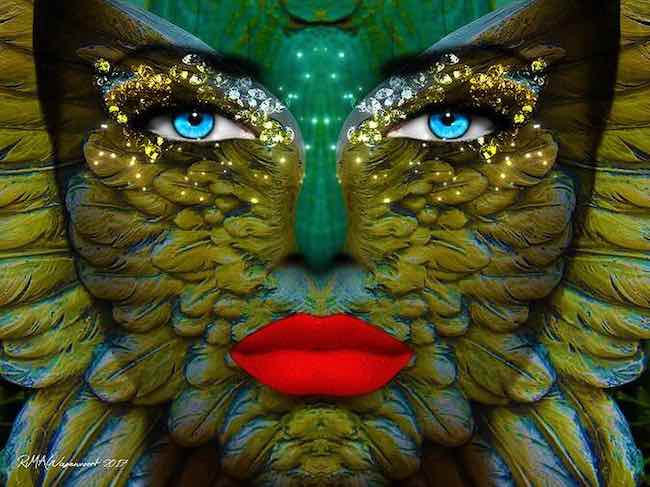
Robin Wagenvoort ha partecipato a numerose mostre e concorsi internazionali vincendo più di venti premi grazie al suo incredibile talento espressivo in cui la fotografia si avvolge della magia dell’Arte Digitale ma soprattutto della capacità visionaria di un sognatore.
ROBIN WAGENVOORT-CONTATTI
Email: r.m.a.wagenvoort@online.nl
Sito web: https://rmawagenvoort1986.wixsite.com/digital-face-art
Facebook: https://www.facebook.com/RMA.Wagenvoort/
The magnetic faces of Robin Wagenvoort, between photography and Digital Art revealing a visionary imagination
Contemporary art is often structured through contaminations that were unimaginable until the last century, becoming a testimony of how much openness there has been comparing to the traditional guidelines that had dominated the artistic past. Consequently, the executive approach of creative artists is modified and adapted to their personal inclination, without any limits either on the choice of subjects of emotional narration, or on the expressive style, or even on the technique through which they let their sensations or their imagination run free. The artist I am going to tell you about today confronts and manifests his rich and sensitive inner world by reinterpreting and mixing a photographic narrative mode with the innovation of digital image modification, focusing on the faces of imaginary characters sometimes inspired by the technologies of the world of cinema.
The historical moment between the end of the 19th century and the beginning of the 20th century not only saw traditional art revolutionised by an innovative wind that the more conservative cultural salons were unable to oppose, but also witnessed the advent of new methods of image reproduction that were initially hindered due to their coldness, the lack of the painter’s hand to infuse talent and skill into a portrait or landscape. Photography, this is the name of the innovative discovery, although still limited to black and white, effectively replaced the work of the artist especially with regard to family portraits as it guaranteed a much cheaper, and therefore more accessible, alternative with a result more faithful to reality; the advent of this technique also met with opposition from the artists themselves, many of whom decided to create movements in which the plastic gesture was predominant over the observed, thus affirming the superiority of art. Suprematism, De Stijl, Lyrical and Geometric Abstractionism, all tended, at least in their initial intention, to move away from the representation of an image that could easily be reproduced by a cold and impersonal device.
Once the first phase of experimentation and dissent had passed, photography took on different connotations from those of portraiture and began to become a medium in which the gaze of the person taking the shot made a difference to the final result; great names such as Doisneau, Henri Cartier-Bresson, Sebastiao Salgado, Gianni Berengo Gardin, immortalised and left to posterity timeless and emotionally charged moments of poetry. But the evolution and rapidity with which innovations followed one another in the 20th century soon led to the discovery of new means of making and generating images, such as the computer that saw the birth of Computer Art, born from an idea of Ben Laposky and Manfred Frank, later transformed into Digital Art, which could not only create graphic signs from nothing but also go on to act on and modify through a refined editing process, photographs taken with the new digital devices. From the embellishment of a pre-existing image to the creation and superimposition of fully digitally edited shots, the range of action of Digital Art is endless and is suitable for the customisation of each creative. Robin Wagenvoort, a Dutch artist born into a family of musicians, soon discovered that his natural inclination pushed him towards another form of expression, the figurative one mainly related to photography. Indulging his nature, his parents allowed him to pursue specific studies, taking courses in portraiture, studio photography, architectural photography, mechanical photography, image editing and graphic design with the Indesign programme, which he then chose to pursue as a self-taught artist.
Subsequently refining his editing technique with the artist Jaap Baart, who glimpsed Robin Wagenvoort’s talent and agreed to give him private lessons, he was able to apply the most advanced techniques to his mastery of portraiture, to which he combined imagination and visionary skills that led him to create fascinating and mysterious images sometimes inspired by another creative world, that of cinema, where technique and special effects complement the skills of the actors but also of that invisible substratum of make-up artists, set designers and cinematographers whose work is essential to the final result and success of each movie. Wagenvoort’s imagination leads him to blend the faces of beautiful models, whose mysterious and magnetic charm he manages to bring out in the observer who cannot escape the intensity of the gaze on which the artist’s expressive essence is focused. But his most distinctive trait is his ability to literally mould the basic images by intervening with three-dimensional editing that allows the faces to take on a sci-fi, surprising and hypnotic appearance. His digital alterations open up the gaze to to the dream of a world that goes beyond the subject but in fact belongs to his memory, to his desires, to an experience of a particular juncture or to something as yet unexperienced but that he would like to live, or even to certain characteristics of the human being that are revealed by virtue of the metaphors with which Wagenvoort from time to time accompanies his protagonists; the artwork Peacock Face tells of vanity, one of the deadly sins according to the Catholic religion, but basically also an inescapable part of human nature, especially in contemporary times where appearance exceeds even being. There is no judgement on the part of the artist, rather acceptance of a way of being even when it is distant from one’s own, admiration for the self-confidence that people who tend to take care of their image display, despite sometimes concealing inner fragilities that are never revealed. In the two artworks dedicated to Venice, on the other hand, Wagenvoort deals with different themes, because after all, the human being is nothing more than a composition of emotions and moods based on the moment experienced, or interpreted on the basis of character and existential differences; In Beauty of Venice Face, in fact, the theme is that of masks, both the beautiful and scenographic ones of the lagoon city’s famous carnival, and those that man wears to hide his essence or to adapt to his surroundings, like a chameleon who too often, in his changes, overshadows himself to the point of forgetting who he really is. What emerges in this work is the contemporary difficulty, but which in the end has belonged to every era, of having to correspond to a model in contrast with the natural characteristics of the individual and which generates a frustration due to the fear of never being able to be oneself to the full. In Venice Face, on the other hand, Robin Wagenwoort concentrates his work on the feeling of memory, on that emotional memory that is indissolubly linked to a place experienced, to images left inside that inner treasure chest that can be opened whenever the interiority feels the need to reconnect with a sensation breathed in, perceived at a particular juncture.
Here the superimposition on the face is the characteristic aquatic images of Venice, as if the protagonist did not want to detach herself from the enchanting moment when her eyes were lost in beauty. And again in The vision of Nelson Mandela, Wagenvoort pays tribute to the great South African politician and his dream of defeating racial segregation by transforming his country, but also the whole of Africa and why not? the whole world, into a place where whites and people of colour could have the same rights; in this artwork, emerges all the love of a man for his land, for which he allowed himself to be imprisoned in order not to give up on his goal of defeating unjust laws, arriving with resilience and perseverance to win and to become, after his release, president of South Africa. The image of the continent is superimposed on Mandela’s face, as if to emphasise the unbreakable bond between him and his land. Robin Wagenvoort has participated in numerous international exhibitions and competitions, winning more than twenty prizes thanks to his incredible expressive talent in which photography is enveloped in the magic of Digital Art, but above all in the visionary capacity of a dreamer.


